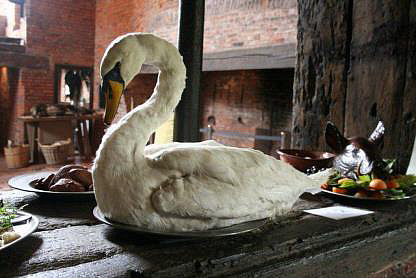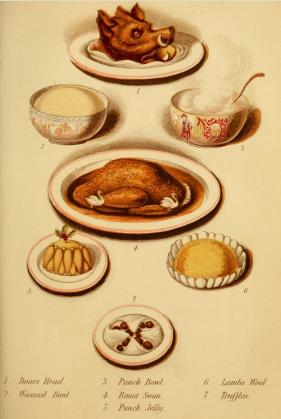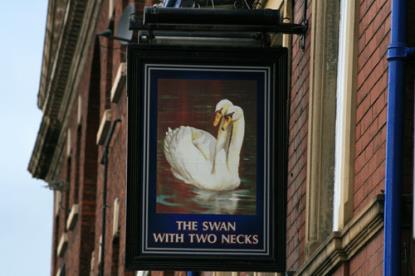

|
  Image: Gainsborough Old Hall Swan appears in food books from early mediaeval times right up to the mid nineteenth century, almost invariably roasted. Mrs.B mentions it merely in passing as a dish that had by then (1861) all but disappeared. There is a certain tradition that rost swan, like peacock, is re-clothed in its skin and feathers for presentation at table.  Boar’s Head and Roast Swan From: Warne’s Model Housekeeper (1882)  Original Receipt in the 15th Century ‘Austin Manuscripts’ (Austin 1440) Original Receipt in the 15th Century ‘Austin Manuscripts’ (Austin 1440)Swan rosted. Cut a Swan in the rove [roof] of the mouthe toward the brayne enlonge, and let him blede, and kepe the blode for chawdewyn; or elles knytte a knot on his nek, And so late his nekke breke; then skald him. Drawe him and roast him even as thou doest goce in a poyntes, and serve him fort wit chawd-wine. Swan appears to have fallen out of favour simply due to the difficulty in domesticating it, the unwillingness of hunters to take this impressive bird, and the meat, which is reportedly inedibly tough, rank and entirely unpleasant. Swan is a ‘Royal’ bird only by popular attribution, just as the Lion is a ‘King’. There is a persistent myth that The Queen owns all the swans in England, or controls them, or is the only person allowed to eat them, or some such. As far as we can establish, The Crown merely takes control of all unmarked mute swans (Cygnus olor) on certain stretches of the river Thames and its surrounding tributaries. The Queen acting as Seigneur of the Swans, permits the Worshipful Companies of Vintners and Dyers, at the annual ‘Swan Upping’ to mark and thereby control those mute swans, but takes no direct authority over any other breed of swan than the mute, nor over swans anywhere other than a very small part of the River Thames. Swans enjoy statutory protection under the Wildlife and Countryside Act 1981.  Thames swans are now marked by ringing, but were formerly ‘nicked’ on the beak, two nicks for the Vintner’s Company, hence the not uncommon pub name of ‘Swan with Two Nicks’, often corrupted to ‘Necks’. The Vintners’ Company still hold a ‘Swan Feast’ on the last Thursday of November, but no longer eat swan. So superior was swan that in 1482 Edward IV enacted the Swans Act which declared that only wealthy land-owners could own swans, confirmed by carving an emblem on the bird’s beak. Any swan held by a “yeomen and husbandmen and other persons of little reputation” could be seized by a member of the aristocracy “whereof the King shall have one half, and he that shall seize, the other half”. The swan meat occasionally available from specialist suppliers in the UK is generally from Australia or South-Eastern USA. Swan has historically been served with ‘Chawdron‘, a sauce made from the birds giblets.  Original Receipt in the verse cookery book ‘Liber Cure Cocorum‘, 1430 (Liber Cure 1430); Original Receipt in the verse cookery book ‘Liber Cure Cocorum‘, 1430 (Liber Cure 1430);Sawce for swannus. Take tho offal and tho lyver of tho swan, In gode brothe thou sethe hom than; When hit is sothyne, take oute the bonus, Smalle hew tho flesshe, Syr, for the nonus; Make alyoure of crust of brede, Of blode of swanne, that sothun is lede, Caste powdur of gynger and clawes ther to, Of peper and wyn thou take also, And salt hit then and sethe hit wele; Cast in thy flesshe, hewen yche a dele, And messe hit forthe, as I the kenne, Set hit in sale before goode menne For other swan dishes see: Budby Pie Chawdron Roast Cygnet  |
|
MORE FROM Foods of England... Cookbooks ● Diary ● Index ● Magic Menu ● Random ● Really English? ● Timeline ● Donate ● Royalty ● English Service ● Food Map of England ● Lost Foods ● Accompaniments ● Biscuits ● Breads ● Cakes and Scones ● Cheeses ● Classic Meals ● Curry Dishes ● Dairy ● Drinks ● Egg Dishes ● Fish ● Fruit ● Fruits & Vegetables ● Game & Offal ● Meat & Meat Dishes ● Pastries and Pies ● Pot Meals ● Poultry ● Preserves & Jams ● Puddings & Sweets ● Sauces and Spicery ● Sausages ● Scones ● Soups ● Sweets and Toffee ● About ... ● Bookshop ● Email: [email protected] COPYRIGHT and ALL RIGHTS RESERVED: © Glyn Hughes 2022 BUILT WITH WHIMBERRY |